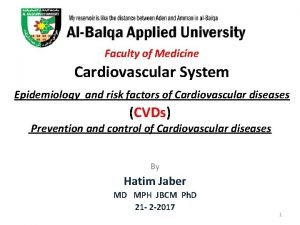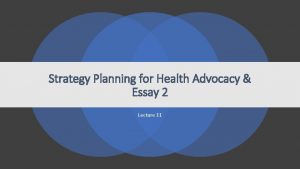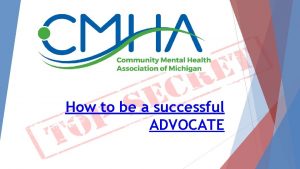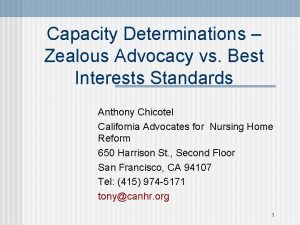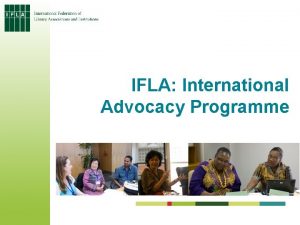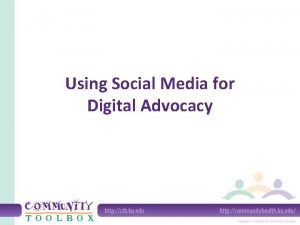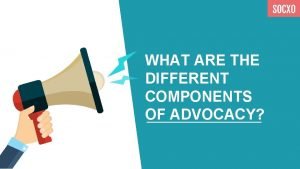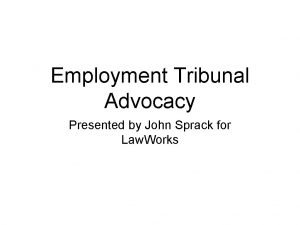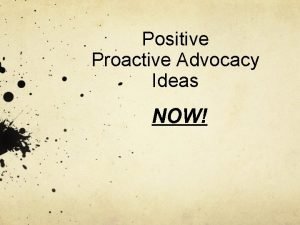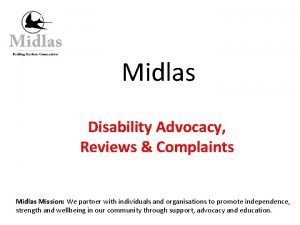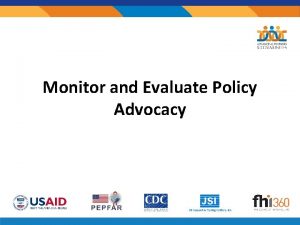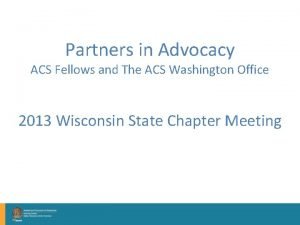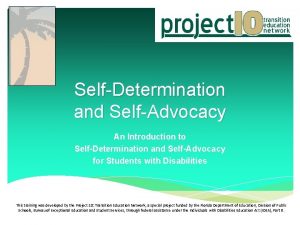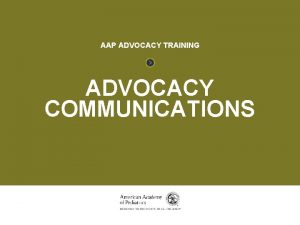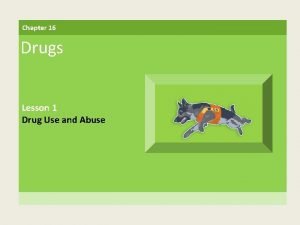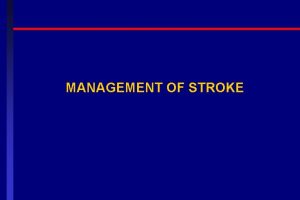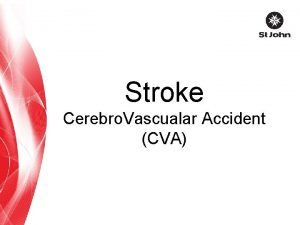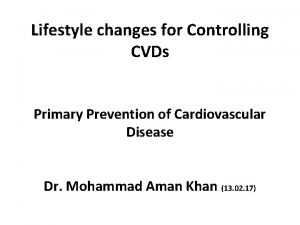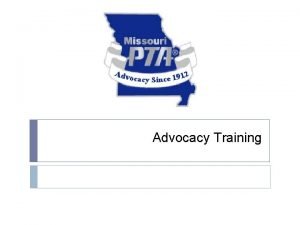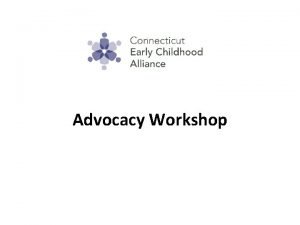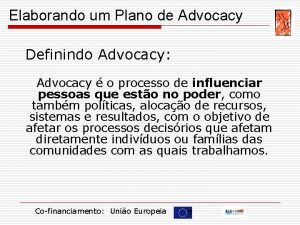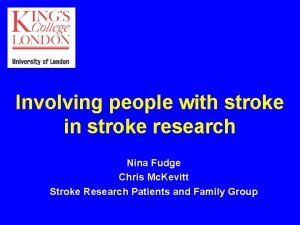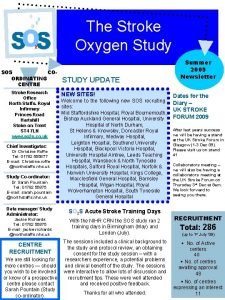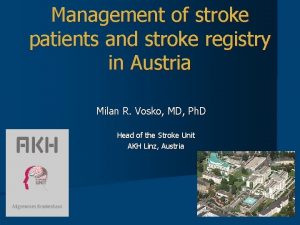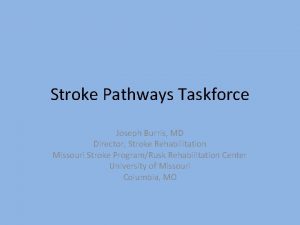Successful advocacy experiences on CVDs Stroke advocacy in






















- Slides: 22


Successful advocacy experiences on CVDs: Stroke advocacy in Europe Arlene Wilkie, Stroke Alliance for Europe, Director General

My presentation • Stroke Alliance for Europe – who we are and what we do (2 slides) • Top 9 tips for successful advocacy in stroke (11 slides) • What we have achieved and what we are doing (5 slides)

Who we are • Stroke Alliance for Europe (SAFE) • Membership organisation • 36 stroke support organisations • 30 countries • Represent SSOs views • Represent the voice of patients, survivors and carers

What we do Vision To work towards greatly decreasing the number of strokes in Europe and that all who are touched by stroke get the help and support they need. Aims To reduce the numbers and the effects of strokes across Europe. Current priorities • Support stroke patients to receive better access to specialist care and rehabilitation • Encourage and grow stroke support organisations • Campaign at EU level • Disseminate the results of EU research projects • Raise awareness of secondary prevention of strokes • Ensure strong governance and sustainable resources for SAFE

Why advocacy? • Stroke services differ between countries • Each country is autonomous in final decisions of the health services within the country = need for country specific actions • Local hospitals and regions could set up own approach leading to inequalities of care within a country • Health and care provision cannot fulfilled only internally within the stroke profession or by a stroke support organisation Solution: • A cooordinated national/regional leadership approach • Involving all relevant stakeholders • Requires decision makers on policies, priorities and resources within a country = Ministers of Health, regional health departments

Tip 1: involve the right people 1. Professional societies • provide professional advice and expertise to decision makers • cover all aspects of stroke prevention and stroke care • provide scientific and economic data and evidence • provide epidemiology data, and health and care service data • provide solutions to a long term plan 2. Stroke support organisations • bring the lived experience – the voice of the stroke survivor • support the development of patient reported outcome measure (PROMs) • provide data and evidence from the patient perspective • demand for improvements in health care (Bill of Rights, World Stroke Organisation) • demand participtation rights in policy development (Partcipation Act of Regione Lazio 2019) • provide solutions to a long term plan

Tip 2: understand the challenges you face • Competition of attention and resources with other diseases • General elections and ever changing contacts • Political platform is very different from the scientific one or normal day to day one • most of us have not received any training in taking health issues to the political/Ministry of Health level • Establishing and retaining contacts and communication • Time to prepare, to follow up and to keep up the pressure

Tip 3: review what have others done In some countries: • communication with Ministers of Health, regional health departments politicians, civil servants is already established • there are national stroke plans • learn from good examples (from all parts of the stroke chain)

Tip 4: research your political world – understand who is best placed to do what you want Find someone/people to advise you and support your work • Ask all your contacts to introduce to members of parliament etc they know • Ask your local stroke support organisation and national scientific society members who may already have good political contacts • Talk to your local member of parliament • Identify the public/private institutions that are already working on stroke/or could be potential partners • If money allows, bring in advocacy/communications expertise

Tip 4 contd: research your political world – understand who is best placed to do what you want Once you have found your advisory champion(s) • Learn about your country's political system • National ministries of health, federal/regional health ministries, health committees, parliamentary groups • Agree where you need to exert pressure

Tip 5: think like a politician or civil servant For a meeting or briefing document - the questions that will be asked: 1. 2. 3. 4. 5. 6. Why should stroke specifically be addressed? What are your arguments? How can this be solved? Why now? Why is this relevant to my constitiuents? What do you want me to do? Responses need to well prepared, specific and immediate at hand For politicians – keep is short, solutions focused and relevant to their contituents/votes For civil sevants – they need the detail

Tip 6: make arguement/solutions relevant – what is the issue for their constituents What is the problem in your country • Demonstrate the size of the problem • Refer to an evidenced based source document • Demonstrate gaps and inequalities in occurence of stroke and in stroke service • Take the patient story/constituent to the politician – just stating statistics is in sufficient

Tip 6 contd : make it relevant – what is the issue for their constituents Go to them with solutions • Tailored on your country, consistent and sustainable • Show that substantial improvements can be made by their actions • Demonstrate that actions are extremely cost effective for the society Show them how progress can be measured • Surveillance and quality of care • Targets • Key performance indicators Overall – show them how they can be a champion for the people (and win votes)

Tip 7: prepare to be involved – keep up the pressure Get them something to do to show their committment • Plan an event to sign a declaration of committment • Ask questions or whole a debate in parliament • Invite them to your hospitals/units/events • Get photos, media coverage to enable positive publicity for them Attract and retain their attention – keep up the noise: • Distribute campaign reports, send briefings ahead of debates • Attend Parliamentary Group and health committee meetings • Hold regular events (Parliamentary receptions on stroke awareness or report launch days) • Attend at Party Conferences • Be known by other Government bodies (Relevant committees, advisory/regulatory bodies)

Tip 8: Don’t be shy The arguments for stroke are good!

SAFE work phase 1: data/evidence www. safestroke. eu

Stroke is an increasing cause for concern BUT it is a viable investment proposition Investing in stroke care Three interventions which are in the latest stroke guidelines: • the treatment of atrial fibrillation to prevent stroke • mechanical thrombectomy (the clot retrieval from the blood vessel in the brain) treatment in the acute phase of stroke • rehabilitation after stroke Interventions work – overall • increase outcomes • tend to generate cost savings • generally good value for money for all countries involved in the research

SAFE work phase 2: solution

Stroke Action Plan for Europe www. safestroke. eu

SAFE work phase 3: call to action Campaign: to implement the Stroke Action Plan for Europe recommendations within each European country Roadmap: Group meetings: national support organisations and stroke support organisations from across Europe Tools: how-to-sessions (stakeholder analysis, strategy development, involve patients, how to work with politicians) and KPI (12) development across the whole stroke care pathway https: //actionplan. eso-stroke. org/ Action: each country to launch its strategy for improvement in collaboration with policy makers Annual audit: KPI data collection to demonstrate improvement in stroke care

Thank you for listening Arlene Wilkie Arlene. wilkie@safestroke. eu
 Cvds
Cvds Anterior stroke vs posterior stroke
Anterior stroke vs posterior stroke Health advocacy essay
Health advocacy essay Lobby vs advocacy
Lobby vs advocacy Zealous advocacy definition
Zealous advocacy definition What is the importance of advocacy in a community
What is the importance of advocacy in a community International advocacy programme
International advocacy programme Youth empowerment meaning in tagalog
Youth empowerment meaning in tagalog What is digital advocacy
What is digital advocacy Components of advocacy
Components of advocacy What is advocacy
What is advocacy Employment tribunal advocacy
Employment tribunal advocacy Positive advocacy
Positive advocacy Midlas advocacy
Midlas advocacy Monitoring and evaluation in advocacy
Monitoring and evaluation in advocacy Advocacy pronounciation
Advocacy pronounciation Partners in advocacy
Partners in advocacy Trubner's record of rizal
Trubner's record of rizal Advocacy work
Advocacy work Ecumenical advocacy alliance
Ecumenical advocacy alliance Self-determination worksheets pdf
Self-determination worksheets pdf Aap cpti
Aap cpti Advocacy brochure about drugs
Advocacy brochure about drugs
